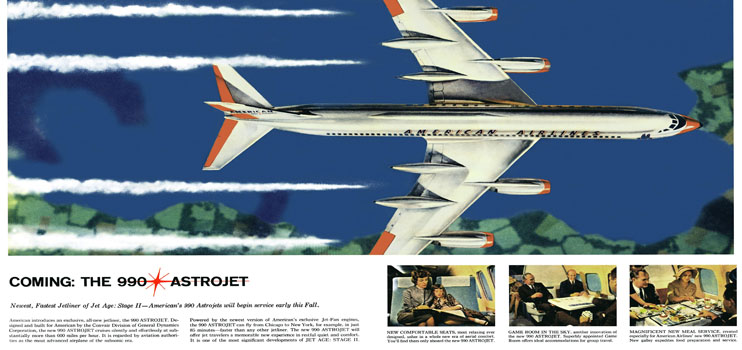The Need For Speed (Or Not)
13 September, 2015
3 min read
When jet airliners first entered service in the late 1950s, the quantum leap from flying 300 mph to jetting aloft at nearly 600 mph seemed mind-boggling. But when faster and more powerful fanjets arrived in the early 1960s, the bar was raised even further, and one airliner in particular emerged as the world’s fastest. Built by the Convair Division of General Dynamics, the 990 was considered by all who flew her as “The Maserati of Jets.”
Pictured in this dramatic ad for American Airlines, the 990 was simply in a class by itself. With wings swept back 39-degrees and four 16,000-lb.-thrust General Electric CJ-805 turbofan engines derived from the military J79 that powered Mach 2 aircraft, the 990 cruised at 635 mph. Flying at this speed shaved 45 minutes from a transcontinental trip across the U.S., and advertised as “The Jet Age: Stage II”, American’s sleek 990 Astrojet offered uncontested performance advantages over any other jet transport in the sky.
Visually, the 990 was easily identified by its four sleek anti-shock bodies, or ‘speed pods’ mounted on the inboard trailing edges of its high-performance wing. These area rule devices, designed by famed aerodynamicist Richard C. Whitcomb, controlled critical airflow by reducing shockwave build-up over the wing at speeds greater than Mach .80 (525 mph). The pods also served as fuel tanks to augment the aircraft’s range.
The 990 was advertised as the world’s fastest, but that performance came at a price. Although jet fuel was plentiful and relatively inexpensive at the time, the 990’s hearty consumption did not go unnoticed. Add to this the fact that the jetliner had a smaller-diameter fuselage and carried between 96 and 121 passengers compared to the larger 150-seat Boeing 707 or Douglas DC-8, and one can see that from an operational standpoint, the 990’s promised trade-off in speed may not have been worth it over the long haul.
First flown on January 24, 1961, the 990 suffered significant teething problems during initial flight tests. After undergoing suitable (and costly) structural modifications, American Airlines introduced its 990 Astrojet in the U.S. while Swissair inaugurated 990 Coronado service on European domestic routes. Other operators included SAS and Thai under lease agreements, plus VARIG, Northeast, Garuda, Spantax, and several private travel clubs later in the airplane’s service career.
As impressive an airliner as the 990 was, only 37 of the type were built. When combined with financial losses on its smaller sibling, the Convair 880, the 990’s paltry sales and associated development problems ultimately spelled the end to Convair’s proud heritage as a builder of some of the finest commercial airliners in the world. In the airliner game, as with the classic fable, sometimes being the fastest does not always win the race.
Next Article
Virgin gets nod for Tiger deal

Get the latest news and updates straight to your inbox
No spam, no hassle, no fuss, just airline news direct to you.
By joining our newsletter, you agree to our Privacy Policy
Find us on social media
Comments
No comments yet, be the first to write one.

